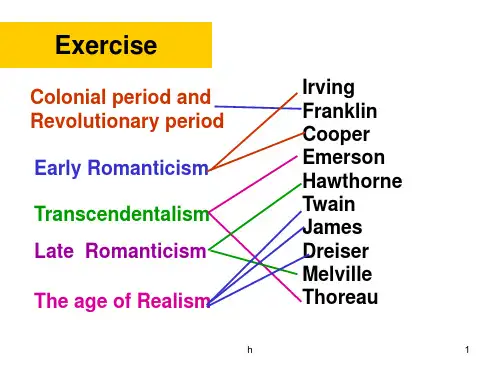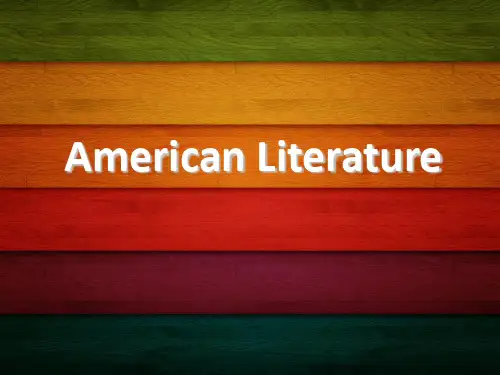殖民主义时期的美国文学英文 ppt课件
- 格式:ppt
- 大小:1.33 MB
- 文档页数:28
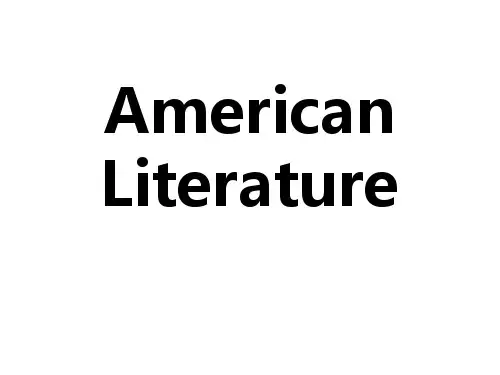
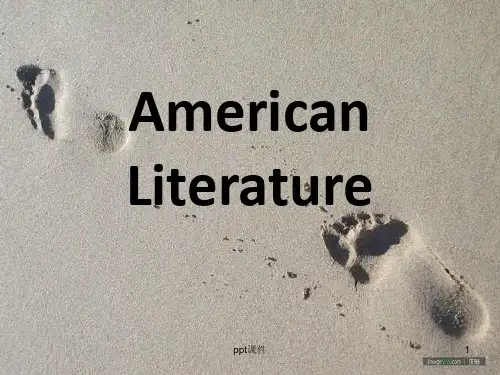


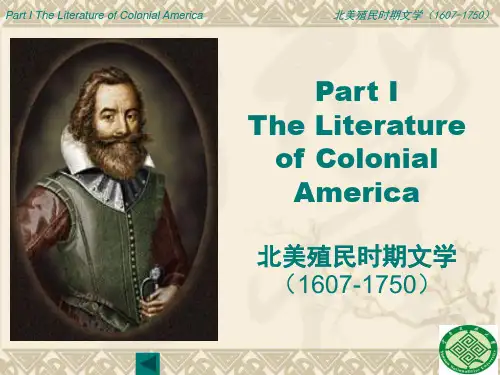
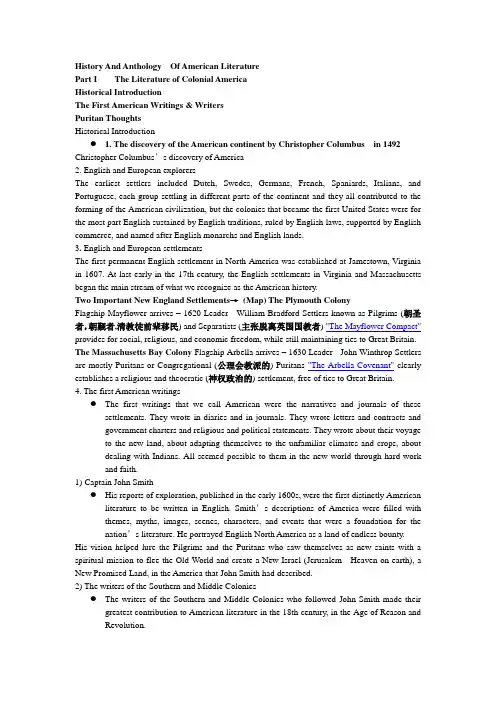
History And Anthology Of American LiteraturePart I The Literature of Colonial AmericaHistorical IntroductionThe First American Writings & WritersPuritan ThoughtsHistorical Introduction● 1. The discovery of the American continent by Christopher Columbus in 1492 Christopher Columbus’s discovery of America2. English and European explorersThe earliest settlers included Dutch, Swedes, Germans, French, Spaniards, Italians, and Portuguese, each group settling in different parts of the continent and they all contributed to the forming of the American civilization, but the colonies that became the first United States were for the most part English sustained by English traditions, ruled by English laws, supported by English commerce, and named after English monarchs and English lands.3. English and European settlementsThe first permanent English settlement in North America was established at Jamestown, Virginia in 1607. At last early in the 17th century, the English settlements in Virginia and Massachusetts began the main stream of what we recognize as the American history.Two Important New England Settlements→(Map) The Plymouth ColonyFlagship Mayflower arrives – 1620 Leader - William Bradford Settlers known as Pilgrims (朝圣者,朝觐者,清教徒前辈移民) and Separatists (主张脱离英国国教者) "The Mayflower Compact" provides for social, religious, and economic freedom, while still maintaining ties to Great Britain. The Massachusetts Bay Colony Flagship Arbella arrives – 1630 Leader - John Winthrop Settlers are mostly Puritans or Congregational (公理会教派的) Puritans "The Arbella Covenant" clearly establishes a religious and theocratic (神权政治的) settlement, free of ties to Great Britain.4. The first American writings●The first writings that we call American were the narratives and journals of thesesettlements. They wrote in diaries and in journals. They wrote letters and contracts and government charters and religious and political statements. They wrote about their voyage to the new land, about adapting themselves to the unfamiliar climates and crops, about dealing with Indians. All seemed possible to them in the new world through hard work and faith.1) Captain John Smith●His reports of exploration, published in the early 1600s, were the first distinctly Americanliterature to be written in English. Smith’s descriptions of America were filled with themes, myths, images, scenes, characters, and events that were a foundation for the nation’s literature. He portrayed English North America as a land of endless bounty.His vision helped lure the Pilgrims and the Puritans who saw themselves as new saints with a spiritual mission to flee the Old World and create a New Israel (Jerusalem---Heaven on earth), a New Promised Land, in the America that John Smith had described.2) The writers of the Southern and Middle Colonies●The writers of the Southern and Middle Colonies who followed John Smith made theirgreatest contribution to American literature in the 18th century, in the Age of Reason and Revolution.●William Byrd II Thomas JeffersonUntil that time, literature developed slowly, especially in the South. Farms widely dispersed. Towns were few. Illiteracy was high. And there was little of the religious ferment and zeal that inspired such a tide of literature to flow from Puritan New England.The First American Writer●Captain John Smith (1580-1631) was the first American writer and he published eight inall.●1)A True Relation of Such Occurrences and Accidents of Note as Hath Happened inVirginia Since the First Planting of That Colony(1608), defending the handling of the settlement and proclaiming the merits of the new land●2) A Map of Virginia: with a Description of the Country (1612), a guide to the countryand an invitation to the bold sprits needed to enlarge and strengthen the English plantations in the new land●3) General History of Virginia (1624), containing his most famous tale of how the Indianprincess Pocahontas saved him from the wrath of her father Powhatan●Captain John Smith contributed more to the survival of the Jamestown colony than didanyone else. And he saw from the beginning what was eventually to be a basic principle of American history, the need of “workers”instead of “gentlemen” for the tough job of planting colonies and pushing the frontiers westward.Early New England Literature●New England: →(Map)● A region of the northeast United States comprising the modern states of Maine, NewHampshire, Vermont, Massachusetts, Connecticut, and Rhode Island.1) A literature of ideas: New England had from the beginning a literature of ideas: theological, moral, historical, political. The Puritans had come to New England for the sake of religious freedom, while Virginia had been planted mainly as a commercial venture. Southern society was almost completely rural, interested primarily in the development of a tobacco economy.●2) Theocracy:The Puritans in New England embraced hardships, together with thediscipline of a harsh church. The first intention in Massachusetts was to found a theocracy —a society in which God would govern through the church. The church thus became the supreme political body. The ideal may have been inspiring, but because of the imperfections of the human material, in practice theocracy often led to injustice and intolerance (不容异说, 偏狭).●3) The Puritan values that dominated much of the earliest American writing: Overthe years the puritans built a way of life that was in harmony with their somber religion, one that stressed hard work, thrift (节俭;节约), piety (虔诚;虔敬), and sobriety (节制;严肃). These were the Puritan values that dominated much of the earliest American writing, including the sermons, books, and letters of such noted Puritan clergyman as John Cotton and Cotton Mather.●Cotton Mather wrote more than 450 works, an example as well as an advocate of thePuritan ideal of hard work.4) The American poets: The American poets who emerged in the 17th century adapted the style of established European poets to the subject matter confronted in a strange, new environment. Anne Bradstreet was one such poet.William Bradford and John Winthrop● 1. William Bradford (1590-1657), first governor of Plymouth. He wrote The History ofPlymouth Plantation (1856).●William Bradford started the History in 1630, ten years after the Mayflower voyage,beginning his story with an account of the small group of Puritans who migrated from England to Amsterdam and then to the New World. In addition to History, Bradford left a wealth of letters, other prose writings about the colony, and even a narrative poem.●He was perhaps the greatest of the Pilgrim Fathers. The New England colonies mournedhim at his death, in words written later by Cotton Mather, as “a common blessing and father to them all”.●The Pilgrim Fathers: English Puritans who went to America in 1620 and founded thecolony of Plymouth, Massachusetts2. John Winthrop (1588 –1649), first governor at Boston. He wrote The History of New England (1826).John Winthrop began to keep a journal on the Bay Colonists’voyage to Massachusetts aboard the ship Arbella in 1630 and he maintained this practice for the rest of his life. The History is less appropriate than “journal”, for the work has not the scope and order of a history. Yet it remains Winthrop’s chief work.● 3. Importance of the Histories●Both works are notable for their candid simplicity and honesty. Each book is the mostvaluable kind of historical source---an account of events by a man who has been a major figure of his time. Both accounts were written, not from literary ambition, but from a sense of the need to record important events in permanent form. Yet, through a direct and vigorous prose style, each account attained literary excellence.Puritan Thoughts● 1. What was a Puritan?●The “Puritan”was “a would-be purifier”. Puritans wanted to make pure their religiousbeliefs and practices. The word was coined by the opponents of the group and was applied to them in scorn; it was intended to ridicule them as persons who thought themselves holier or better than others. The undaunted Puritans claimed the name for themselves, adopting it as a badge of honor (荣誉徽章).● 2. What did the Puritans want to do?●The Puritans wished to restore simplicity to church services and the authority of the Bibleto theology. They felt that the Church of England was too close to the Church of Rome in doctrine, form of worship, and organization of authority. Another point of controversy was that the Church of England was the established church, that is, the official church of the state, and the most extreme Puritans, among them the Plymouth Plantation group, felt the influences of politics and the court had led to corruption within the church.●These Puritans were “Separatists”--- that is, they wished to break free from the Churchof England. The Massachusetts Bay group, on the other hand, wished to reform the church but remain a part of it. Yet once they were settled in the new land, they too moved gradually toward complete separation.● 3. What kind of people were the Puritans?●Puritans include people from the humblest to the loftiest ranks of English society, botheducated and uneducated, poor and rich. The Puritans looked upon themselves as a chosen people, and it followed logically that anyone who challenged their way of life was opposing God’s will and was not to be accepted. They were thus zealous in defense of their own beliefs but often intolerant of the beliefs of others. They drove out of their settlements all those whose opinions seemed dangerous to them.Puritan opposition to pleasure and the arts has sometimes been exaggerated, but it is true that their lives were disciplined and hard. Puritans tended to suspect joy and laughter as symptoms of sin. They made strict laws about private morality as well as public behavior.●Puritan religious teaching tended to emphasize the image of a wrathful God and to forgethis mercy. From this harsh side of Puritan thought comes the picture of what Nathaniel Hawthorne (author of The Scarlet Letter)called the “stern (严厉的, 苛刻的) and black-browed (黑眉毛的, 抑郁的) Puritans.”Yet this was indeed one of their aspects, but only one. Governor Bradford and Governor Winthrop were men of character, courage, and noble spirit.●Puritanism (the practices and doctrines of the Puritans) was the strongest in the NewEngland region and had great influence upon its history, its people and its literature.4. John Cotton (1584-1652) and Roger Williams●contradictory examples of PuritansJohn CottonThe first major intellectual spokesman of the Massachusetts Bay Colony, sometimes called “the Patriarch of New England.”From the time he came to Boston in 1633, he was the “teacher”( that is, spiritual leader) of the community, and its guiding influence toward the ideal of theocracy ( a state ruled by the church). John Cotton’s primary influence was through the pulpit (讲坛;布道坛).●The people of Massachusetts delighted to hear him preach, and some of his listeners wereconvinced that he could make no mistake, for “God would not suffer Mr. Cotton err (犯错误,出差错)”. Yet err he did, great and good man that he was. Practical circumstances allied him with much less noble spirits than his own in suppressing differences of opinion.●Through John Cotton we can see an important characteristic of the Puritans. They weremuch more concerned with authority than with democracy.●The Puritans faults were those common to persons who hold extreme opinions.Roger Williams●With Williams begins the history of religious toleration in America, and with him, too, thehistory of the separation of church and state. Williams advocated the freedom of belief. In him we have a balance to John Cotton.●Roger Williams was interested in the Indian language. One of his works was A Key intothe Language of America; or, A Help to the Language of the Nation in That Part of America Called New England.Anne Bradstreet and Edward TaylorMany Puritans wrote verse, sometimes using that form for their narratives of actual events. Most Puritan verse was decidedly plodding (沉重缓慢的, 单调乏味的), but the work of the two writers, Anne Bradstreet and Edward Taylor, rose to the level of real poetry.Anne BradstreetAnne Dudley Bradstreet is one of the most interesting of the early poets.Anne Dudley Bradstreet●Both her father and her husband were governors of Massachusetts.●Bradstreet’s first published work appeared in London: The Tenth Muse Lately Sprung Upin America.●She wrote well when she dealt with the simple events of her daily life. The note of piety,gently sounded, was in her work.Edward Taylor: Puritan Preacher and Poet●The best of the Puritan poets was Edward Taylor. His work followed the style and formsof the leading English poets of the mid-seventeenth century.Edward Taylor●Most of Taylor’s work treated religious themes, with many poems based directly on thePsalms.Taylor did not publish any of his work. His poems were found in manuscript in 1937, more than two hundred years after his death. This discovery brought Taylor to immediate prominence in the colonial literary history, and enriched American poetic heritage. A complete edition of Taylor’s poems appeared in 1960.Study Question●The United States has been criticized in recent years for assuming an air of moralsuperiority and for trying to impose its opinion on the rest of the world. Can you find the seeds of these American attitudes in the literature of the first two centuries? Explain your answer by referring to specific works you have read.。
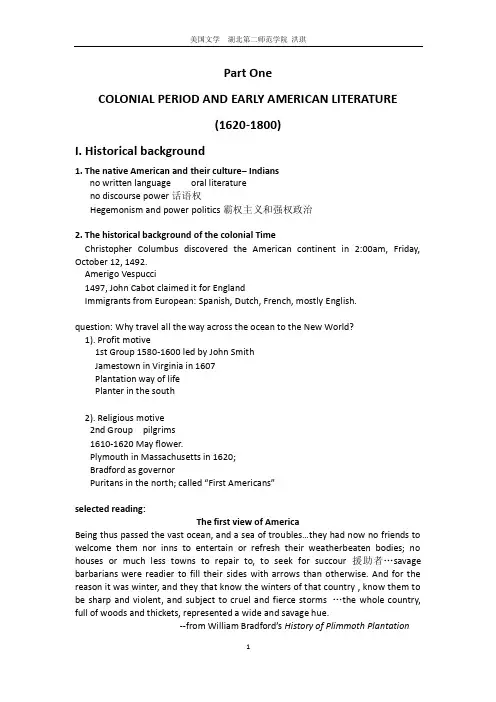
Part OneCOLONIAL PERIOD AND EARLY AMERICAN LITERATURE(1620-1800)I. Historical background1. The native American and their culture– Indiansno written language oral literatureno discourse power话语权Hegemonism and power politics霸权主义和强权政治2. The historical background of the colonial TimeChristopher Columbus discovered the American continent in 2:00am, Friday, October 12, 1492.Amerigo Vespucci1497, John Cabot claimed it for EnglandImmigrants from European: Spanish, Dutch, French, mostly English.question: Why travel all the way across the ocean to the New World?1). Profit motive1st Group 1580-1600 led by John SmithJamestown in Virginia in 1607Plantation way of lifePlanter in the south2). Religious motive2nd Group pilgrims1610-1620 May flower.Plymouth in Massachusetts in 1620;Bradford as governorPuritans in the north; called “First Americans”selected reading:The first view of AmericaBeing thus pa ssed the vast ocean, and a sea of troubles…they had now no friends to welcome them nor inns to entertain or refresh their weatherbeaten bodies; no houses or much less towns to repair to, to seek for succour援助者…savage barbarians were readier to fill their sides with arrows than otherwise. And for the reason it was winter, and they that know the winters of that country , know them to be sharp and violent, and subject to cruel and fierce storms …the whole country, full of woods and thickets, represented a wide and savage hue.--from William Bradford’s History of Plimmoth PlantationII. Puritanism1 Aims of Puritanism(Why did Puritans come to America?) :- to reform and purify the Church of England- to escape religious persecution- to build Theocracy神治国in the new world* God’s chosen people* To seek a new Garden of Eden* To build “City of God on earth”2. The Source and doctrines of PuritanismThey follow the ideas of the French reformer and theologian (神学家)John Calvin Doctrines: Calvinist=Puritan(Total depravity)彻底堕落。
